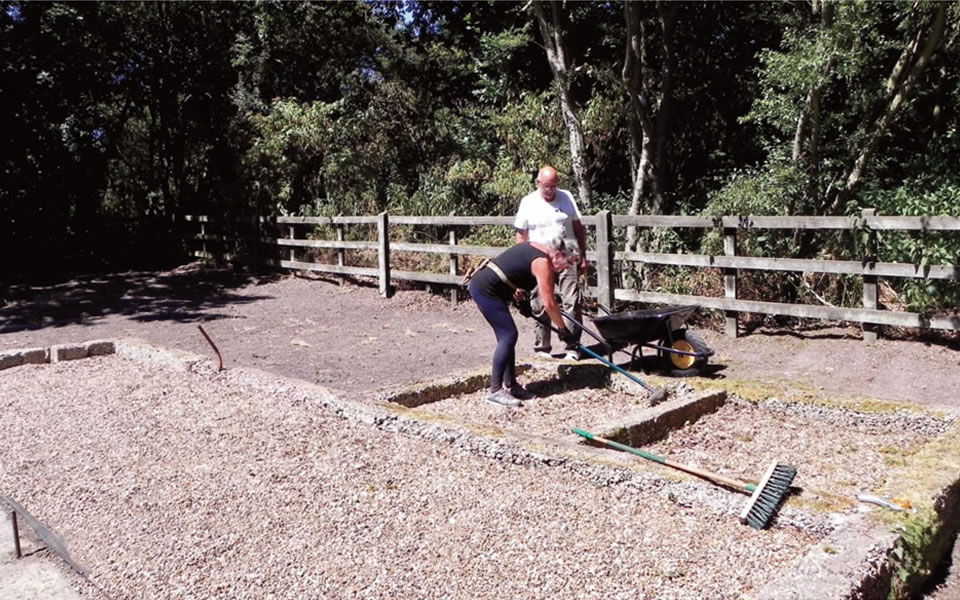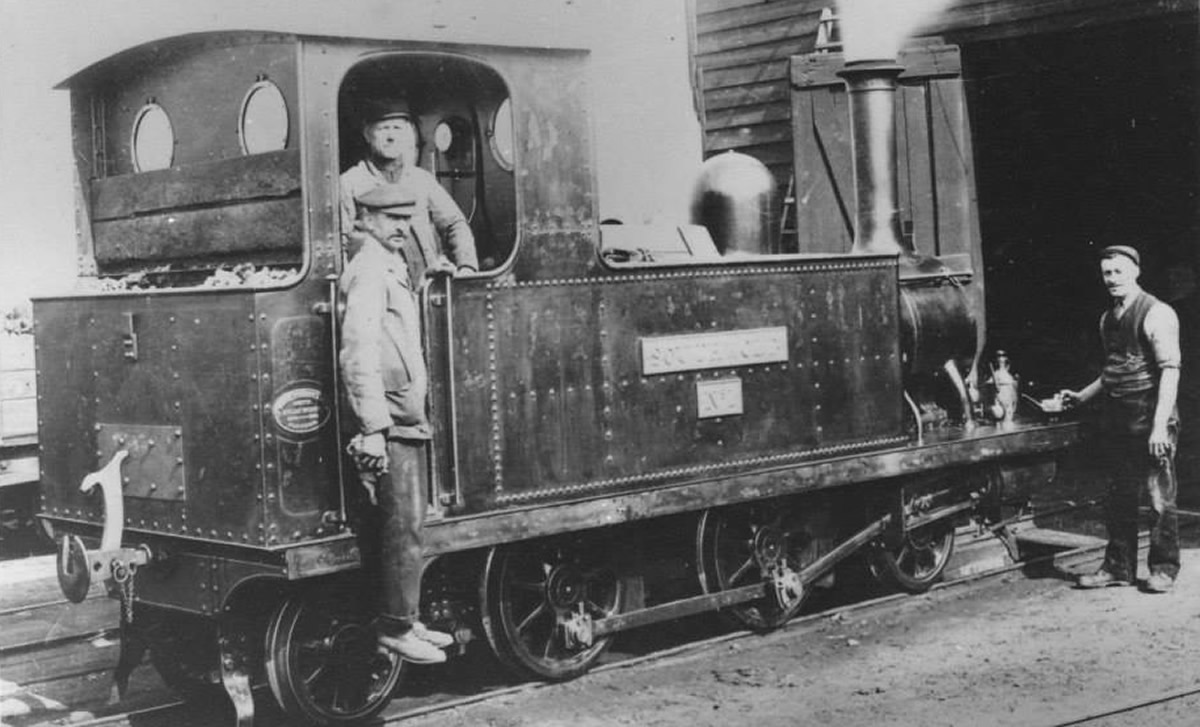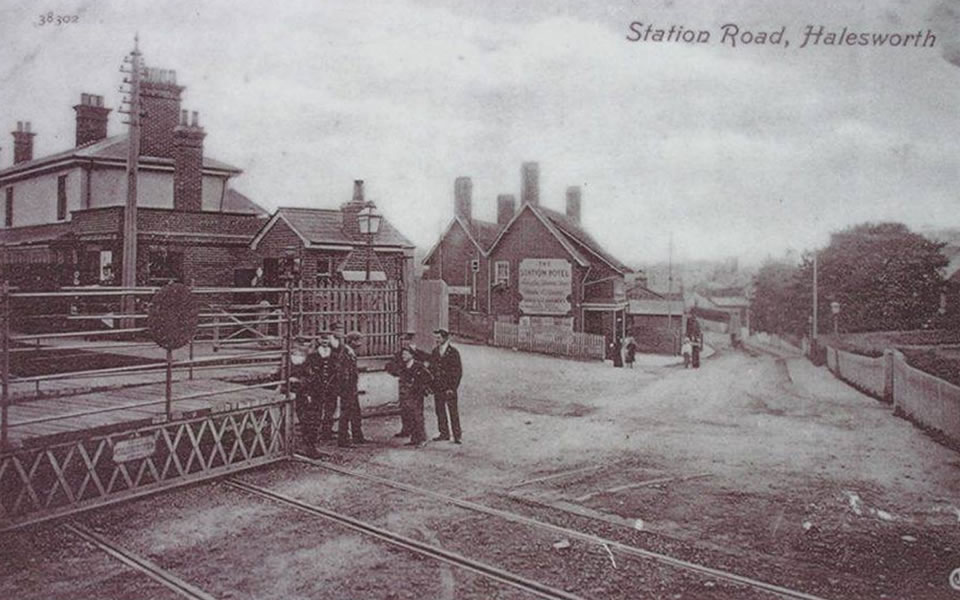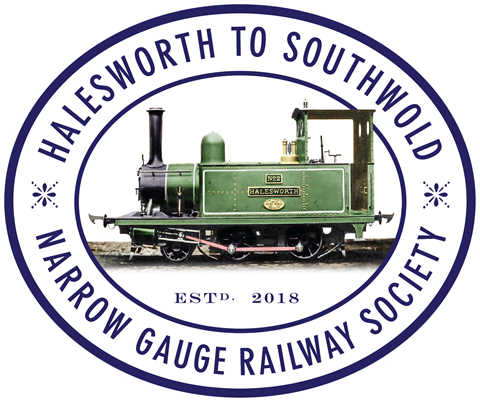The Halesworth to Southwold Railway was a narrow gauge railway line linking Halesworth and its main line GER station to Southwold on the coast. 8 miles 63 1⁄2 chains (14.15 km) long, it was 3 foot (914 mm) narrow gauge. It opened in 1879 and closed in 1929.
The Railway’s History

THE ROUTE OF THE RAILWAY
The route closely followed the River Blyth, with Halesworth and Southwold both on the north side, but the longest section, including the intermediate stations, was on the south side. The line was lifted and the equipment was scrapped in 1941/2 to help with war efforts. One track panel can still be found on the 1914-built Harbour Line and a surviving van body is at the East Anglia Transport Museum. There is also a surviving (but derelict) coal shed at Blythburgh. Substantial civil engineering is still extant – principally at Bird’s Folly, Halesworth (the 1914 locomotive shed and well, and two bridges) – and almost all the railway trackbed is still unencumbered: some is walkable, particularly through woodland known as the Heronry on the south shore of the Blyth estuary.

HISTORY
Southwold has had a harbour since at least Saxon times, but its importance as a port began to decline during the 19th century. In an attempt to reverse the declining fortunes of the town, the Corporation promoted it as a holiday resort, where bathing in private was available on the wide beaches. They expected the East Suffolk Railway from Ipswich to Great Yarmouth to pass through the town, but it was built further inland, due in part to the underlying geology of the area. Although there was a horse bus service which ran to Darsham station once a day, this was not ideal, and a request was made to the railway company for a branch line to Southwold from Halesworth in 1855. The East Suffolk Railway were not prepared to build one, and several similar schemes were proposed over the next 20 years. The Southwold and Halesworth Tramway obtained an Act of Parliament in 1872, with the intention of building a steam tramway between the two towns, using the provisions of the Tramways Act 1870, but they failed to raise sufficient funds, and the project foundered. Still there were calls for a railway, and in October 1875 two public meetings were held. Mr Charles Easton of Easton Hall chaired one in Halesworth, and the Earl of Stradbroke, who lived at Henham Hall, chaired the other in Southwold. Both were local landowners, and they invited a civil engineer called Arthur C Pain to speak, together with Richard C Rapier, who was part of the engineering firm of Ransomes & Rapier. Both speakers suggested that a 2 ft 6 in (762 mm) gauge railway would be considerably cheaper to build than a standard gauge one, and the meetings resulted in the formation of the Southwold Railway Company. Colonel Heneage Bagot-Chester was appointed as chairman, the two speakers became engineers, and the secretary was a local solicitor called H R Allen.
The company obtained an Act of Parliament on 24 July 1876, to allow the line to be constructed. The main line was 8 miles 63 1⁄2 chains (14.15 km) long, running from Southwold to Halesworth, and two branches were also authorised. A 0.48-mile (0.77 km) branch at Halesworth linked up with the Blyth Navigation, and there was a link to Blackshore Quay, between Southwold and Walberswick, which was to be 0.25 miles (0.40 km) long. The company could raise £40,000 in working capital by issuing £10 shares, and also had powers to borrow a further £13,000 by issuing debentures. The gauge of the railway had to be at least 2 ft 6 in (762 mm), and because the line was covered by the Regulation of Railways Act 1868, it could use a simple signalling system and light earthworks, providing loads were limited and speeds did not exceed 25 miles per hour (40 km/h). In practice, this meant that journey times between the two termini would be about 30 minutes, and trains were limited to 100 passengers.

Following a report by C J Wall, a former manager of the Bristol and Exeter Railway, the gauge of 3 feet (914 mm) was chosen. This would make the line somewhat more expensive to build, but it was thought that the increased carrying capacity would offset this. A prospectus was published on 3 November 1877, which mentioned that the company had agreed provisional contracts with Charles Chambers of Westminster, who would build the line and stations for £30,000, and with the Bristol Wagon & Carriage Works Co, who would supply the locomotives and rolling stock for £4,000. The company suffered upheaval around this time, as Allen, the secretary, resigned due to a conflict of interest, when he found himself representing local landowners in their negotiations with the railway. He was replaced by T H Jellicoe, who was joined on the board by the Mayor of Southwold and R C Rapier. Raising finance proved difficult, and when Chambers declined to enter into a proper contract until they were sure that purchase of the land was certain, most of the board resigned on 5 November 1877. Only Rapier and Bagot-Chester remained, to be joined by a new board, who were not local men, whereas all of the previous board except one had been residents of Halesworth. Board meetings moved to Rapier’s London office, and he became chairman on 20 December 1877. Bagot-Chester resigned from the company on 29 January 1879, leaving a board that had no real commitment to the service of the community.
Rapier worked energetically on the project, and £5,000 borrowed from the English & Foreign Credit Co enabled purchase of the land to begin. Contracts were re-negotiated, and construction work began on 3 May 1878. Sleepers were bought from Norway, and arrived by ship at Southwold harbour. The rails came from the Tredegar Iron Co, and also arrived at the harbour. Ransomes & Rapier supplied the signalling and switchgear, and a local blacksmith called Charlie List was responsible for much of the ironwork. The completed works were inspected by the Board of Trade on 19 September 1879, and a celebration lunch was held at the Swan Hotel on 23 September. Torrential rain that night caused significant flooding in Suffolk, and the line near Wenhaston Mill was submerged, but the official opening took place on 24 September, and the first train completed a return journey despite the water. Subsequent trains ran between Southwold and Wenhaston, as the flooding worsened. The intermediate stations at Walberswick and Blythburgh were not completed until later.

OPERATION
The railway was supplied with three locomotives for the opening, built by Sharp, Stewart and Company. They had a 2-4-0 wheel arrangement, and the design was similar to others that the company had supplied for light passenger work. Sharp Stewart also supplied some rolling stock, and accepted debentures in part payment, only receiving one third of the total cost in cash. The six coaches, from the Bristol Wagon Works Co. Ltd., were very unusual, based on Cleminson’s patent flexible six-wheeled underframe, and having longitudinal seats and balconies (later enclosed). All platforms were on the south side of the line, so that (as with the Talyllyn Railway) doors were only provided on that side on passenger stock. The Midland Railway Carriage and Wagon Co provided the freight stock, including Cleminson 6-wheeled open wagons: this design was even used by the MOY Coal Co. for their unique private owner coal wagons.
Construction of the railway had cost £90,000, (equivalent to £8,400,000 in 2016), and the company applied to the Board of Trade for authority to raise more capital in 1880. Income from the operation of the trains did not produce enough surplus to keep paying the debenture interest, and in 1883 Sharp Stewart cancelled their arrangement, repossessing locomotive No. 1. The other two locomotives and the rest of the stock were then hired at £150 per year. In 1888, the company was authorised to raise another £10,000 in debentures, which was used to pay the arrears in interest on the existing debentures, and in 1890 enabled them to purchase the stock outright.
In the first month of operation, the company applied to the Board of Trade for permission to run the line as a light railway and this was granted on 11 March 1880. A maximum speed of 16 miles per hour (26 km/h) was specified, and it was to be worked by one engine in steam. Operation of the swing bridge (which was opened and closed by hand) was achieved using an Annett’s key, which was attached to the staff, which the working engine was required to carry. Passenger traffic for the first ten years was fairly static, at around 76,000 journeys per year, but goods traffic doubled to reach 9,000 tons. The next ten years saw a steady increase, with passenger journeys rising to 100,000 by 1900, while 9,000 tons of minerals and 6,000 tons of parcels were carried. In order to cope with the increase, another locomotive was ordered from Sharp Stewart in 1893. It was of a similar design to the originals, but slightly longer, and with a 2-4-2 wheel arrangement, providing a more-accessible coal bunker, and reducing the uncomfortable “boxing” (side-to-side motion) experienced with the 2-4-0s, particularly when running in reverse. It carried the name “Southwold” and the number 1, as its predecessor had done.

Neither of the two branches (to Halesworth Quay, and to Southwold Harbour) specified by the original Act were built, due to a lack of funds, and the powers were allowed to lapse. At Halesworth, the single platform had a shelter for the passengers, and was connected to the Great Eastern station by a footbridge. There was a partly-roofed raised timber platform between one of the sidings and a standard gauge siding, where goods were transhipped: two staff were employed full-time in this work. In 1908, loops were added at Blythburgh and Wenhaston, and train control was managed by having a staff for each section.
Many of the trains were mixed goods and passenger workings, with the shunting at intermediate stations adding to the journey time for the passengers. The stock did not have a continuous brake, and although the Board of Trade raised the issue at regular intervals, the railway was always able to point to its clean record for transporting passengers, and somehow managed to avoid having to fit one. In connection with the increase in business, both covered vans were rebuilt and enlarged, and most of the coaching stock had its end-balconies enclosed.
In 1906 it was announced that the line would be widened from its existing narrow gauge to standard gauge, to allow carriages and wagons to come direct through from Halesworth, and to join up with the planned Mid-Suffolk Light Railway route from Haughley Junction, thus providing a new route to the coast in competition with the GER. This was not carried out (although most of the route – including the swing bridge at Southwold – was widened, and the locomotive shed at Halesworth built to standard gauge).
After several years of negotiation, the harbour Line to Southwold Harbour was built in 1914, but fishing tonnages were already dropping, and the entire line was taken over by the War Ministry: the Harbour Line was used to transfer coals and freight to the small fleet of navy ships in the harbour. Large number of troops used the main line on their way to training camps, and to the front.
Also in 1914, Manning Wardle 0-6-2T “Wenhaston” was bought to manage the increased freight tonnage expected with the Harbour Branch’s completion: in the event, this powerful locomotive took over much of the Halesworth to Southwold service, and ran the last few months up to closure almost on its own.

CLOSURE
The railway started to lose money, because of the economic depression and road competition, and closed suddenly on 11 April 1929: all the stock (except for one locomotive), rails and stations were abandoned in situ. The LNER instituted a bus service between Halesworth and Southwold as a replacement. In 1940 Southwold Council recommended to the Minister of Supply to confiscate the railway assets for conversion into munitions.
PROPOSED RE-ESTABLISHMENT OF THE LINE
The Southwold Railway Society (later the Southwold Railway Trust) was formed in 1994 to “investigate the possibility of re-establishing part of the line and to promote this if re-establishment was shown to be possible” The trust has, however, failed to obtain planning permission to rebuild any of the railway on its original trackbed – even on land that is trust-owned at Wenhaston Station. A tourist attraction called “Steamworks”, with a miniature railway, is in the process of being established on ex-industrial land in Southwold.
In April 2018, a new Society – the Halesworth to Southwold Narrow Gauge Railway Society – was set up by ex-Trustees of the SRT, and others, to concentrate on restoring the Halesworth (western) end of the line: in agreement with Halesworth Millenium Green, which owns most of the trackbed at Halesworth, work re-started to enhance the presentation of the 1914 locomotive shed site and the original bridges, at Bird’s Folly. The Society has also, in agreement with the Southwold Harbour Commissioners, produced artwork for a planned information board at Blackshore Quay, where the remaining track panel is to be found.

LOCOMOTIVES
| No. | Name | Builder | Type | Wks No. | Built | Notes |
|---|---|---|---|---|---|---|
| (1) | Southwold | Sharp Stewart | 2-4-0 T | 2848 | 1879 | Returned to makers, 1883 |
| 1 | Southwold | Sharp Stewart | 2-4-2 T | 3913 | 1893 | Scrapped, 1929 |
| 2 | Halesworth | Sharp Stewart | 2-4-0 T | 2849 | 1879 | Scrapped, 1941 |
| 3 | Blyth | Sharp Stewart | 2-4-0 T | 2850 | 1879 | Scrapped, 1941 |
| 4 | Wenhaston | Manning Wardle | 0-6-2 T | 1845 | 1914 | Scrapped, 1941 |
